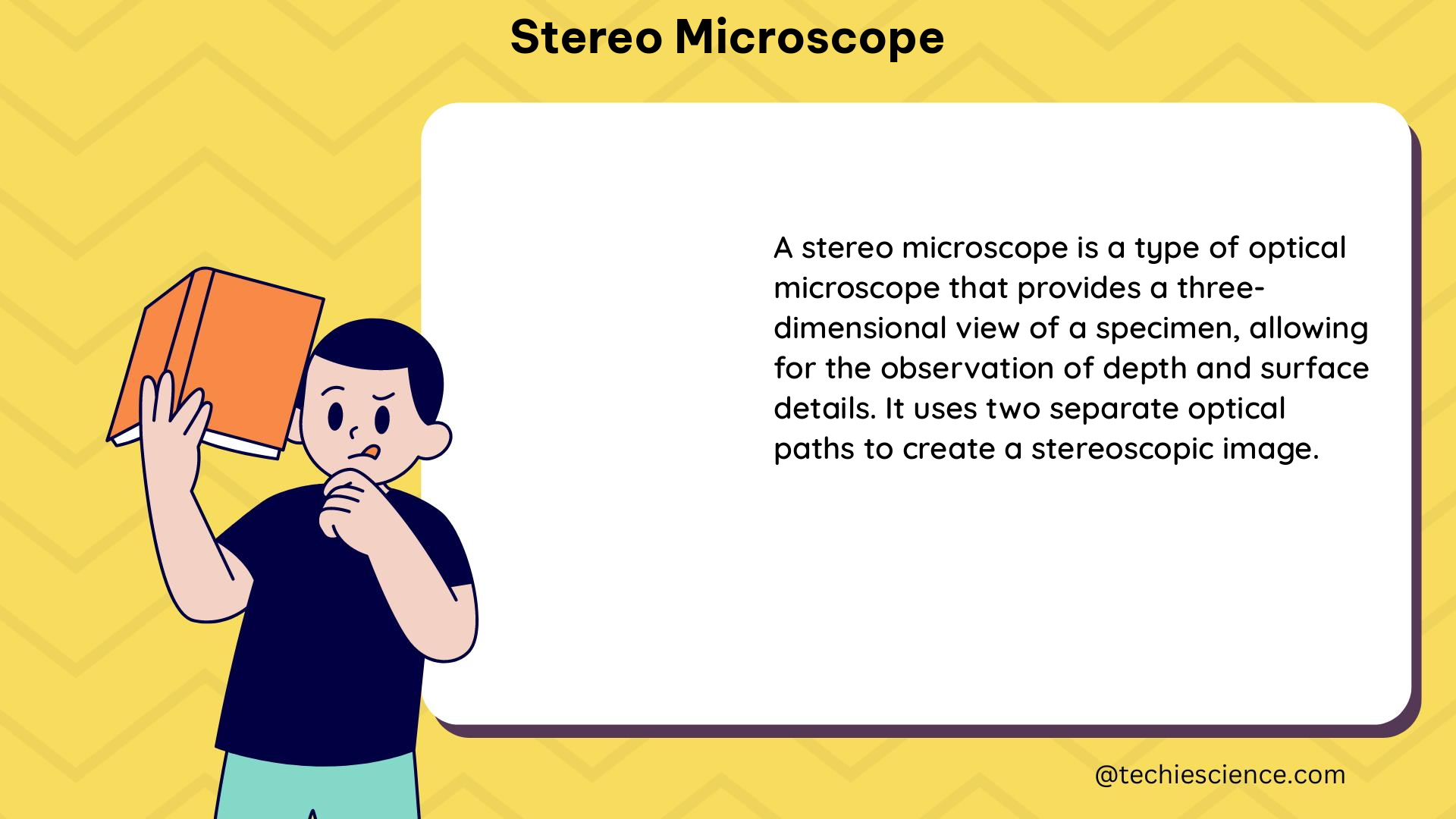Stereo microscopes, also known as dissection microscopes or stereomicroscopes, are a specialized type of microscope that provide a three-dimensional view of a sample. These instruments are widely used in various fields, including biology, materials science, and electronics, for observing and analyzing relatively large and opaque specimens. With their unique optical design and versatile features, stereo microscopes offer a wealth of capabilities that make them an indispensable tool for scientific exploration and research.
Understanding the Optical Design of Stereo Microscopes
The key feature that distinguishes stereo microscopes from other types of microscopes is their use of two separate optical paths, each with its own objective lens and eyepiece. This binocular arrangement allows the user to perceive depth and three-dimensional structure, providing a more natural and intuitive viewing experience compared to traditional compound microscopes.
The optical design of a stereo microscope typically consists of the following components:
-
Objective Lenses: Stereo microscopes employ two objective lenses, one for each optical path. These lenses can have a wide range of magnification powers, typically ranging from 1x to 40x. The choice of objective lenses determines the overall magnification and resolution of the microscope.
-
Eyepieces: The two eyepieces, one for each eye, allow the user to view the sample in a three-dimensional manner. The eyepieces can have varying magnification levels, often ranging from 1x to 10x, which can be combined with the objective lenses to achieve the desired overall magnification.
-
Zoom Mechanism: Many stereo microscopes feature a zoom mechanism that allows the user to continuously adjust the magnification without changing the objective lenses. This provides a seamless transition between different magnification levels, enabling the user to explore the sample in greater detail.
-
Illumination System: Stereo microscopes often incorporate built-in illumination systems, such as LED or halogen lights, to provide optimal lighting for the sample. The illumination can be adjusted to enhance contrast and reveal fine details.
-
Working Distance: One of the key advantages of stereo microscopes is their large working distance, which can range from a few inches to several inches. This allows the user to manipulate the sample directly under the microscope, making it particularly useful for tasks such as dissection, assembly, and repair.
Magnification and Resolution Considerations

The magnification and resolution of a stereo microscope are crucial factors to consider when selecting the appropriate instrument for your specific application. The overall magnification is determined by the combination of the objective lens and the eyepiece magnification.
For example, if a stereo microscope has a 4x objective lens and a 10x eyepiece, the overall magnification would be 40x (4x × 10x). It’s important to note that increasing the magnification does not necessarily result in higher resolution, as the resolving power of the microscope is primarily determined by the numerical aperture (NA) of the objective lens.
The numerical aperture is a dimensionless quantity that represents the light-gathering ability of the lens. A higher numerical aperture generally corresponds to a higher resolving power, allowing the microscope to distinguish smaller details. Typical numerical apertures for stereo microscope objectives range from 0.1 to 0.3.
To achieve the desired magnification and resolution, it’s essential to carefully select the appropriate combination of objective lenses and eyepieces based on your specific needs and the characteristics of the sample you’re observing.
Quantitative and Qualitative Measurements with Stereo Microscopes
In addition to their primary role in observation, stereo microscopes can also be used for quantitative and qualitative measurements. These measurements can provide valuable insights into the physical properties and characteristics of the sample.
Some common measurements that can be performed with stereo microscopes include:
-
Dimensional Measurements: Stereo microscopes can be used to measure the length, width, height, and perimeter of a sample. This information can be crucial in applications such as materials science, engineering, and quality control.
-
Area Measurements: The two-dimensional area of a sample can be determined using the measurement capabilities of a stereo microscope. This is particularly useful in fields like biology, where the size and distribution of cells or tissues need to be quantified.
-
Fluorescence Intensity Measurements: Stereo microscopes can be equipped with fluorescence imaging capabilities, allowing for the quantification of fluorescence intensity within a sample. This is valuable in applications such as cell biology and molecular biology.
-
In Situ Hybridization: Stereo microscopes can be used to visualize and analyze the spatial distribution of specific DNA or RNA sequences within a sample, a technique known as in situ hybridization. This is an important tool in genetics and developmental biology.
To ensure accurate and reliable measurements, it’s essential to follow best practices for image acquisition and analysis. This includes using lossless file formats, adjusting exposure time to avoid saturation or lack of dynamic range, and correcting for any illumination or background variations.
Practical Applications of Stereo Microscopes
Stereo microscopes find a wide range of applications across various scientific and industrial fields. Some of the key areas where these versatile instruments are commonly used include:
-
Biology and Life Sciences: Stereo microscopes are indispensable tools in fields such as zoology, botany, and microbiology, where they are used for the observation and analysis of larger biological specimens, such as insects, plant structures, and tissue samples.
-
Materials Science and Engineering: Stereo microscopes are valuable in materials science and engineering applications, where they are used to examine the surface topography, defects, and microstructural features of materials, including metals, ceramics, and polymers.
-
Electronics and Microelectronics: In the electronics and microelectronics industries, stereo microscopes are used for the inspection, assembly, and repair of small electronic components, printed circuit boards, and other delicate devices.
-
Forensics and Crime Scene Investigation: Stereo microscopes play a crucial role in forensic investigations, where they are used to examine and document evidence, such as fibers, hair, and small fragments, at the crime scene or in the laboratory.
-
Jewelry and Gemology: Stereo microscopes are indispensable tools in the jewelry and gemology industries, where they are used to inspect, grade, and identify precious stones, as well as to examine the craftsmanship and details of jewelry pieces.
-
Archaeology and Paleontology: Stereo microscopes are employed in the fields of archaeology and paleontology to study and document small artifacts, fossils, and other delicate historical and paleontological specimens.
-
Quality Control and Inspection: In various manufacturing and production settings, stereo microscopes are used for quality control and inspection purposes, ensuring the quality and consistency of products, components, and materials.
The versatility and capabilities of stereo microscopes make them an essential tool for a wide range of scientific and industrial applications, enabling researchers, engineers, and professionals to explore the world in greater detail and make informed decisions based on their observations and measurements.
Emerging Trends and Future Developments in Stereo Microscopy
The field of stereo microscopy is continuously evolving, with ongoing advancements in technology and the introduction of innovative features. Some of the emerging trends and future developments in this field include:
-
Digital Imaging and Image Analysis: The integration of digital imaging capabilities, such as high-resolution cameras and advanced image processing software, is transforming the way stereo microscopes are used. These advancements enable more precise quantitative analysis, automated measurements, and the creation of detailed digital records of samples.
-
Increased Magnification and Resolution: Researchers and manufacturers are continuously working to develop stereo microscopes with higher magnification and improved resolving power, allowing for the observation and analysis of smaller features and structures.
-
Specialized Accessories and Attachments: The stereo microscope market is seeing the introduction of specialized accessories and attachments, such as fluorescence imaging modules, polarization filters, and 3D imaging capabilities, expanding the versatility and applications of these instruments.
-
Automation and Robotics: The integration of automation and robotic systems with stereo microscopes is enabling more efficient and precise sample handling, positioning, and analysis, particularly in high-throughput applications.
-
Miniaturization and Portability: The development of compact and portable stereo microscopes is making these instruments more accessible and suitable for field work, on-site inspections, and remote locations where traditional laboratory equipment may not be feasible.
-
Augmented and Virtual Reality: Emerging technologies, such as augmented reality (AR) and virtual reality (VR), are being explored to enhance the user experience and provide new ways of interacting with and visualizing samples under a stereo microscope.
-
Artificial Intelligence and Machine Learning: The integration of artificial intelligence (AI) and machine learning algorithms is enabling more advanced image analysis, automated feature recognition, and intelligent decision-making capabilities within stereo microscopy systems.
As the field of stereo microscopy continues to evolve, these emerging trends and future developments are poised to revolutionize the way scientists, engineers, and professionals observe, analyze, and interact with the microscopic world, opening up new avenues for discovery and innovation.
Conclusion
Stereo microscopes are versatile and powerful instruments that play a crucial role in a wide range of scientific and industrial applications. With their unique optical design, these microscopes provide a three-dimensional view of samples, enabling users to observe and analyze larger, opaque, and complex specimens in greater detail.
By understanding the technical specifications, measurement capabilities, and practical applications of stereo microscopes, researchers, engineers, and professionals can leverage these instruments to unlock new insights, improve quality control, and drive advancements in their respective fields.
As the field of stereo microscopy continues to evolve, the integration of digital imaging, automation, and emerging technologies promises to further enhance the capabilities and accessibility of these versatile instruments, paving the way for even more groundbreaking discoveries and innovations in the years to come.
References
- Quality Digest – Microscopes: Seeing the Unseen
- Global Stereo Microscope Market Report
- Quantifying Microscopy Images: Top 10 Tips for Image Acquisition
- Stereomicroscope – ScienceDirect
- Stereo Dissecting Microscopes 101 – Bite Size Bio

Hi, I am Sanchari Chakraborty. I have done Master’s in Electronics.
I always like to explore new inventions in the field of Electronics.
I am an eager learner, currently invested in the field of Applied Optics and Photonics. I am also an active member of SPIE (International society for optics and photonics) and OSI(Optical Society of India). My articles are aimed at bringing quality science research topics to light in a simple yet informative way. Science has been evolving since time immemorial. So, I try my bit to tap into the evolution and present it to the readers.
Let’s connect through